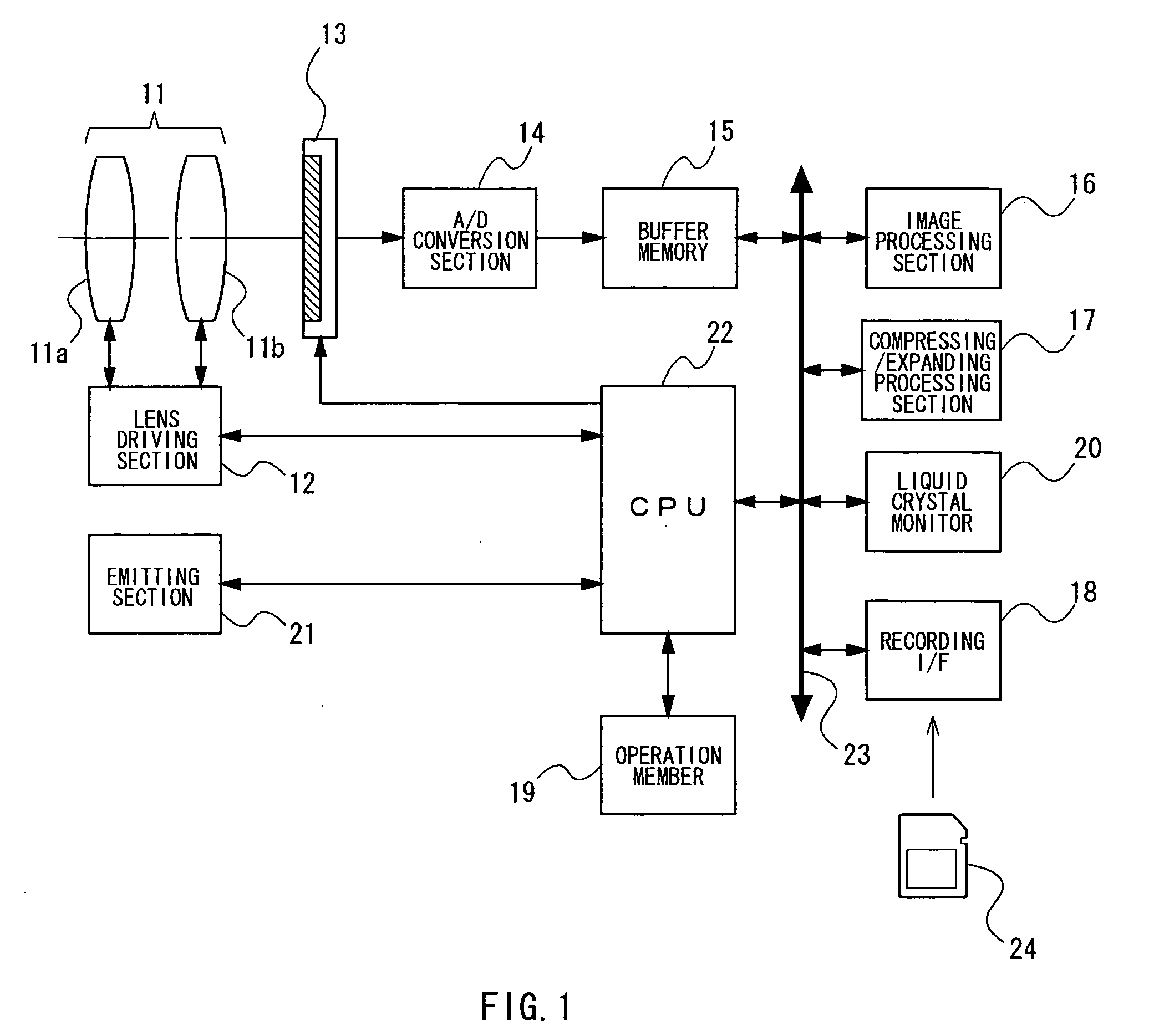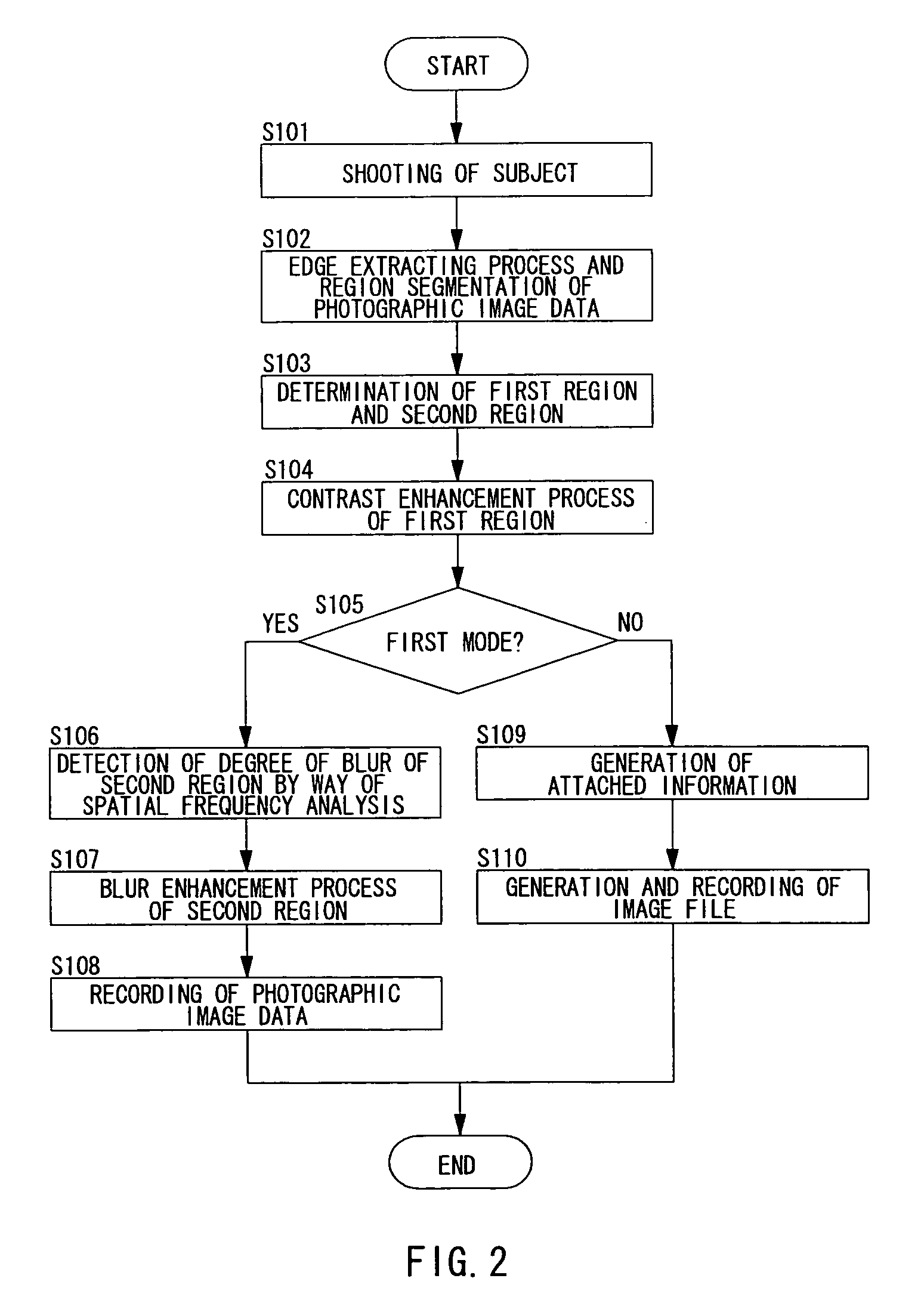Imaging Device, Image Processing Device, and Program
- Summary
- Abstract
- Description
- Claims
- Application Information
AI Technical Summary
Benefits of technology
Problems solved by technology
Method used
Image
Examples
first embodiment
Variation of First Embodiment
[0095]In the first embodiment, information of the degree of blur of an image is obtained by performing the DCT transform over the entire second region (S106). However, the CPU 22 may perform frequency analysis with respect to the outline portion of the image of the second region, and, based on the high frequency component of the outline portion in the second region, determine the degree of blur of the image.
[0096]As an example, based on the result of the edge extracting process (S102) by the image processing section 16, the CPU 22 specifies the outline portion of the second region. Then, the compressing / expanding processing section 17 performs DCT transform only on each of the pixel blocks containing the outline portion of the second region of the photographic image data. Then, the CPU 22 obtains the DCT coefficient of the outline portion of the second region as information of the degree of blur of the image. Of course, the CPU 22 may calculate the high ...
second embodiment
Description of Second Embodiment
[0097]FIG. 10 is a flow chart illustrating operation in the “blur enhancement mode” of an electronic camera of a second embodiment. Here, in the second embodiment and a third embodiment, since the block diagrams of an electronic camera are common to that of FIG. 1, illustrations of them will be omitted in figures, and common configurations will be denoted by the same reference numerals, and their description will be omitted.
[0098]The second embodiment is a variation of the first embodiment, and differs from the first embodiment in that, as illustrated in FIGS. 11(a) to 11(c), the second region is further segmented into a plurality of sub-regions depending on the degree of blur, and the blur enhancement process is performed on the image of the second region for each of the sub-regions, respectively. In addition, since S201 to S205 in FIG. 10 correspond to S101 to S105 in FIG. 2, respectively, and S209 to S211 in FIG. 10 correspond to S108 to S110 in FI...
third embodiment
Description of Third Embodiment
[0103]FIG. 12 is a flow chart illustrating the operation in the “blur enhancement mode” of an electronic camera of a third embodiment.
[0104]The third embodiment is a variation of the first example, and differs from the first embodiment in that, based on first photographic image data shot with emitting light at an emitting section 21 and second photographic image data shot without emitting light, the image of first photographic image data is segmented into a first region and a second region. In addition, since S311 to S313 in FIG. 12 correspond to S108 to S110 in FIG. 2, respectively, duplicated descriptions thereof will be omitted.
[0105]Step S301: A user instructs an electronic camera to image a subject by way of full-pressing operation of a release button. The CPU 22 of the electronic camera images a subject image by causing the emitting section 21 to emit light and driving the image sensor 13 at the time of releasing. Then, based on the image signal ...
PUM
 Login to View More
Login to View More Abstract
Description
Claims
Application Information
 Login to View More
Login to View More - Generate Ideas
- Intellectual Property
- Life Sciences
- Materials
- Tech Scout
- Unparalleled Data Quality
- Higher Quality Content
- 60% Fewer Hallucinations
Browse by: Latest US Patents, China's latest patents, Technical Efficacy Thesaurus, Application Domain, Technology Topic, Popular Technical Reports.
© 2025 PatSnap. All rights reserved.Legal|Privacy policy|Modern Slavery Act Transparency Statement|Sitemap|About US| Contact US: help@patsnap.com



